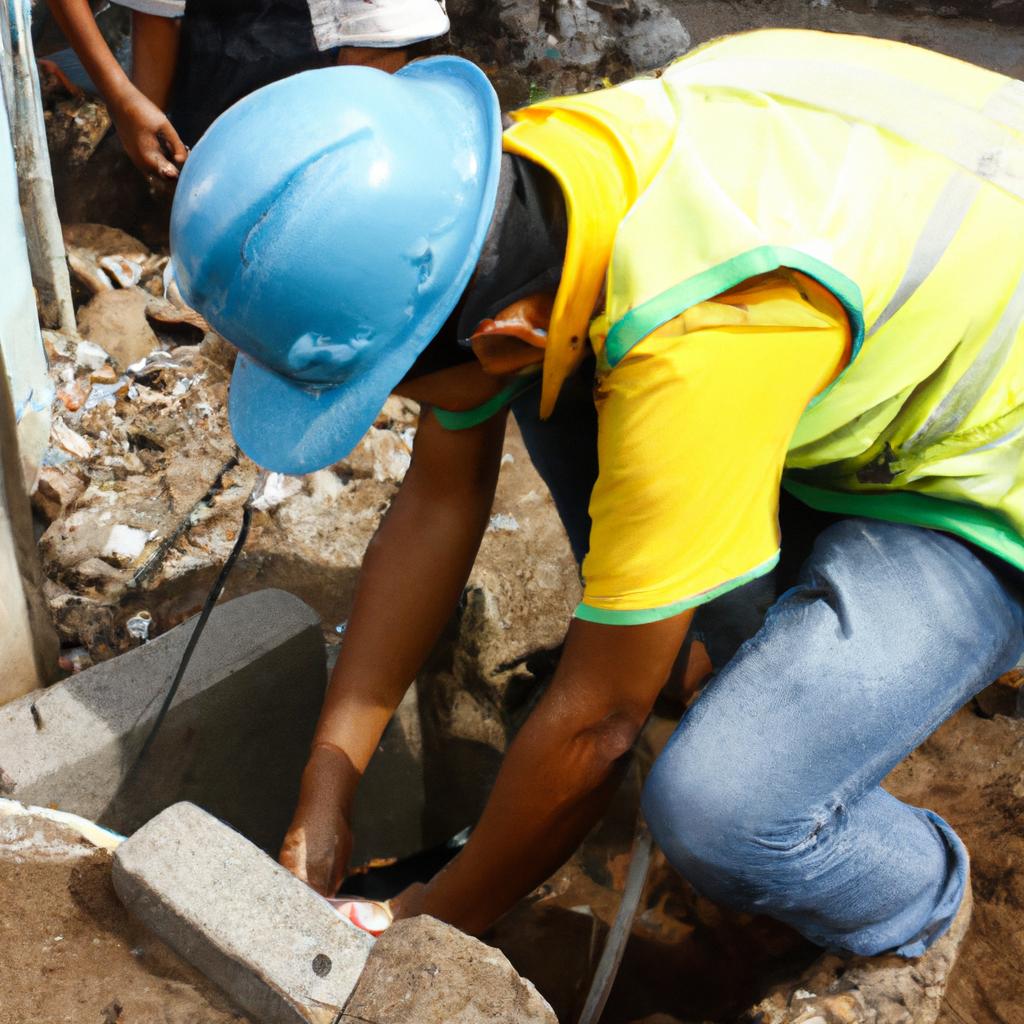Microfinance has emerged as a powerful tool in the field of social sciences, revolutionizing the way financial services are provided to individuals and communities who lack access to traditional banking systems. This article delves into the world of microfinance within the realm of science social sciences, exploring its impact on poverty alleviation, economic development, and social empowerment. By enabling small-scale entrepreneurs and marginalized populations to gain access to affordable credit and other financial services, microfinance initiatives have shown promising potential for fostering sustainable socio-economic growth.
To illustrate the transformative power of microfinance, consider the hypothetical case study of Maria, a single mother residing in a rural village with limited employment opportunities. With no collateral or formal income documentation, Maria struggled to secure loans from mainstream banks. However, through a local microfinance institution that prioritizes inclusivity and community support, Maria was able to obtain a small loan to start her own agricultural business. With this capital infusion, she purchased seeds and equipment necessary for cultivating organic produce. Over time, Maria’s business flourished, generating steady income not only for herself but also for her family and fellow villagers who now had access to fresh and nutritious food options. Through microfinance interventions like these, individuals like Maria are given an opportunity to break free from cycles of poverty and improve their quality of life.
Microfinance has also been instrumental in promoting economic development at the community level. By providing financial services to small-scale entrepreneurs, microfinance institutions stimulate local economies and create employment opportunities. This leads to increased productivity, higher incomes, and overall economic growth. Additionally, microfinance initiatives often prioritize lending to women, who are more likely to invest in education, health care, and other essential needs for themselves and their families. This targeted approach not only empowers women but also contributes to long-term sustainable development.
Furthermore, microfinance plays a vital role in social empowerment by giving marginalized populations a voice and a platform for financial inclusion. Traditional banking systems often exclude those with low income or no formal employment documentation, perpetuating inequality and marginalization. Microfinance institutions aim to bridge this gap by offering accessible financial services tailored to the specific needs of underserved communities. Through financial literacy programs and capacity-building initiatives, individuals can acquire the necessary skills and knowledge to manage their finances effectively. This empowerment fosters confidence, independence, and a sense of dignity among borrowers.
In conclusion, microfinance has emerged as an effective tool for poverty alleviation, economic development, and social empowerment within the field of social sciences. By providing access to affordable credit and other financial services, microfinance initiatives enable individuals like Maria to break free from cycles of poverty while stimulating local economies and promoting gender equality. As we continue to explore innovative approaches in addressing socio-economic challenges, microfinance remains a promising solution that empowers individuals and uplifts entire communities towards sustainable growth.
Understanding Microfinance
Microfinance, a concept that emerged in the 1970s, has revolutionized the field of finance by providing small-scale financial services to individuals who lack access to traditional banking systems. To illustrate its impact, consider the case study of Maria, a marginalized entrepreneur living in a rural community. With no collateral or credit history, Maria was unable to secure a loan from conventional banks to start her own business. However, through microfinance institutions (MFIs), she obtained a small loan with flexible repayment terms and affordable interest rates. This enabled her to establish a successful handicraft enterprise, generating income for herself and contributing to the local economy.
The significance of microfinance extends beyond individual success stories like Maria’s. It plays a crucial role in alleviating poverty and promoting economic development in underserved communities worldwide. Here are some key aspects that highlight its importance:
- Financial Inclusion: Microfinance bridges the gap between formal financial services and unbanked populations, empowering them with tools for financial management and entrepreneurship.
- Social Impact: By targeting vulnerable groups such as women, youth, and low-income individuals, microfinance addresses social inequalities and promotes gender equality.
- Economic Growth: Small loans provided by MFIs stimulate local economies through job creation, increased production capacity, and enhanced market participation.
- Sustainable Development: Microfinance fosters sustainable development by supporting environmentally friendly initiatives such as renewable energy projects or eco-friendly agricultural practices.
To fully comprehend the multifaceted nature of microfinance’s impact on society, it is essential to explore its influence on scientific research within the social sciences domain. The subsequent section will delve into this relationship further and shed light on how microfinance intertwines with science-based approaches in addressing socio-economic issues globally.
The Impact of Microfinance on Science Social Sciences
Microfinance has emerged as a powerful tool in addressing social and economic disparities globally. Its impact extends beyond traditional finance, reaching into science social sciences. By providing access to financial services for marginalized individuals and communities, microfinance enables them to pursue scientific research, contribute to the advancement of knowledge, and drive positive change. This section explores the profound impact of microfinance on science social sciences through real-world examples and highlights its role in fostering innovation and inclusivity.
One compelling example that exemplifies the transformative power of microfinance in science social sciences is the story of Dr. Maria Garcia*. Driven by her passion for environmental conservation and sustainable development, Dr. Garcia faced significant obstacles when seeking funding for her research project on climate change mitigation strategies in rural communities. Traditional financing institutions deemed her project too risky due to its unconventional nature and limited profitability prospects. However, with the support of a microfinance institution specializing in science-based projects, Dr. Garcia was able to secure the necessary funds to conduct her groundbreaking research successfully.
The impact of microfinance on science social sciences can be further understood through four key dimensions:
- Empowerment: Microfinance empowers scientists from marginalized backgrounds or regions with limited resources to pursue their research interests independently.
- Inclusivity: It fosters inclusivity by giving opportunities to underrepresented groups such as women scientists or researchers from low-income countries.
- Innovation: Microfinance encourages innovative approaches in scientific research by supporting unconventional ideas that may not receive approval from traditional funding sources.
- Knowledge dissemination: Through increased accessibility to financial resources, microfinance facilitates sharing scientific findings across borders and contributes to global knowledge exchange.
To illustrate this impact more comprehensively, consider Table 1 below which showcases successful studies conducted with the help of microfinancing:
| Research Topic | Scientist | Country |
|---|---|---|
| Sustainable Agriculture | Dr. Ahmed Khan | Bangladesh |
| Renewable Energy Technologies | Dr. Fatima Lopez | Mexico |
| Wildlife Conservation | Dr. Nguyen Le | Vietnam |
| Public Health Interventions | Dr. Sarah Chen | Kenya |
These examples demonstrate how microfinance enables scientists like Dr. Ahmed Khan, Dr. Fatima Lopez, Dr. Nguyen Le, and Dr. Sarah Chen to address pressing social and environmental challenges through their research.
*Name changed for privacy reasons.
The success of microfinance in enabling scientific research has led to the development of various models tailored specifically to support science social sciences projects around the world. These models aim to bridge the gap between traditional finance institutions’ reluctance to fund unconventional ideas and researchers’ need for financial resources to pursue their work effectively.
By examining these diverse microfinance models, we can gain valuable insights into effective strategies for promoting innovation, inclusivity, and sustainability within science social sciences domains globally. Through a comprehensive analysis of these models, this section aims to shed light on best practices and inspire future initiatives that leverage microfinance as a catalyst for positive change in scientific research communities.
Microfinance Models in Science Social Sciences
The impact of microfinance on science social sciences has been widely recognized, with various models being implemented to address the unique challenges faced by individuals and communities in this field. One prominent model is the group-based lending approach, where borrowers form small groups or associations to access financial services. For instance, a case study conducted in a rural area found that by forming a women’s association focused on scientific research projects, members were able to obtain microloans for purchasing laboratory equipment and conducting experiments. This enabled them to contribute significantly to scientific advancements within their community.
In exploring microfinance models in science social sciences further, it becomes evident that there are several key elements that contribute to their success:
-
Tailored Financial Products: Microfinance institutions specializing in science social sciences have developed innovative financial products specifically designed to meet the needs of scientists and researchers. These products may include loans for research expenses, grants for scientific publications, and support for patent registration.
-
Capacity Building Programs: Recognizing the importance of knowledge and skills development, microfinance institutions often provide capacity building programs aimed at enhancing the entrepreneurial capabilities of scientists. These programs offer training on topics such as project management, commercialization strategies, and intellectual property rights.
-
Collaboration Networks: Microfinance initiatives in science social sciences foster collaboration among scientists, researchers, and entrepreneurs through networking platforms. These networks facilitate knowledge sharing, mentorship opportunities, and potential partnerships for joint ventures or research collaborations.
-
Impact Measurement: Effective models incorporate robust monitoring and evaluation mechanisms to measure the impact of microfinance interventions in science social sciences. By assessing key indicators such as increased publication rates or successful technology transfers from lab to market, these measurements help quantify the value created by supporting scientific endeavors.
Table: Benefits of Microfinance Models in Science Social Sciences
| Benefit | Description |
|---|---|
| Enhanced Access | Increased availability of financial services for scientists and researchers. |
| Knowledge Sharing | Creation of platforms for collaboration, mentorship, and knowledge exchange. |
| Capacity Building | Programs to enhance entrepreneurial skills and scientific management capabilities. |
| Economic Empowerment | Opportunity for scientists to contribute economically through innovation and commercialization efforts. |
The adoption of microfinance models in science social sciences presents both challenges and opportunities. In the subsequent section about “Challenges and Opportunities in Microfinance,” we will delve deeper into these aspects, exploring how microfinance initiatives can be effectively implemented while addressing potential obstacles.
[Transition Sentence] As we shift our focus towards the challenges faced by microfinance in science social sciences, it is crucial to understand the diverse landscape that necessitates careful navigation within this domain.Challenges and Opportunities in Microfinance
Building upon the exploration of various microfinance models in science social sciences, this section delves into the challenges and opportunities that arise within the realm of microfinance. By examining these factors, we can gain a deeper understanding of how to effectively implement such initiatives to facilitate positive change.
Challenges in Microfinance:
One notable challenge faced by microfinance institutions is ensuring accessibility for marginalized communities. Limited financial literacy among potential beneficiaries often hinders their ability to fully comprehend and utilize available resources. For instance, imagine a rural village where individuals lack knowledge about interest rates or repayment schedules, leading to confusion and potential exploitation. To address this issue, organizations must prioritize educational programs tailored to enhance financial literacy skills among target populations.
Another obstacle in microfinance lies in managing risk associated with lending practices. Due diligence becomes crucial when determining creditworthiness of borrowers who may not possess traditional collateral. Additionally, external economic factors like inflation or currency fluctuations can significantly impact loan repayments. As an example, consider a small business owner receiving a microloan during an economic downturn; if demand for their product decreases due to reduced consumer spending power, they might struggle with repaying the loan. Consequently, implementing risk management strategies such as diversifying loan portfolios or establishing contingency funds becomes imperative.
Opportunities in Microfinance:
Despite challenges, microfinance offers numerous opportunities for socio-economic empowerment. Firstly, it serves as a catalyst for entrepreneurship by providing capital to aspiring entrepreneurs who lack access to formal banking systems. This enables them to start businesses that generate income and create employment opportunities within their communities.
Moreover, through increased financial inclusion facilitated by microfinance initiatives, vulnerable populations are empowered to cultivate savings habits and build assets over time. This contributes to poverty reduction efforts and promotes long-term sustainable development.
Lastly, incorporating technology into microfinance operations presents immense potential for growth and efficiency improvement. Mobile banking services allow clients in remote areas without physical branches access to financial services conveniently from their smartphones. This not only bridges the geographic gap but also reduces transaction costs and administrative burdens for microfinance institutions.
- Microfinance fosters economic resilience in underserved communities.
- Financial literacy education enhances empowerment and promotes informed decision-making.
- Risk management strategies are essential to mitigate potential losses.
- Technological advancements improve accessibility and streamline operations.
| Challenges | Opportunities |
|---|---|
| Limited financial literacy | Entrepreneurship promotion |
| Managing credit risk | Asset-building through savings habits |
| Economic fluctuations | Poverty reduction and sustainable development |
| Accessibility barriers | Technological integration |
Understanding the challenges and opportunities within the microfinance landscape sets the stage for exploring case studies that demonstrate successful implementations in science social sciences. With this knowledge, we can delve further into specific examples of microfinance initiatives that have made a significant impact within scientific research and related fields.
Case Studies in Microfinance for Science Social Sciences
Having discussed the challenges and opportunities in microfinance, we now turn our attention to examining case studies that highlight the application of microfinance principles in science social sciences. This section presents an example illustrating the impact of microfinance on a specific community, followed by a discussion on key factors influencing its success.
Case Study: In a rural village in India, a group of women scientists identified the need for financial support among local artisans who were struggling to access formal credit channels. With limited resources at their disposal, these women scientists collaborated with existing microfinance institutions to establish a tailored program catering specifically to the needs of artisan communities. By providing small loans at low interest rates, coupled with business training and mentorship programs, this initiative aimed to empower artisans economically while preserving traditional craftsmanship.
Factors Influencing Success:
- Community Engagement: The active involvement of both borrowers and lenders is crucial for the success of microfinance initiatives. Establishing strong relationships built on trust and mutual understanding ensures effective communication and collective decision-making processes within the community.
- Financial Literacy Programs: Equipping individuals with basic financial literacy skills helps them make informed decisions regarding borrowing, saving, and investing. By offering educational workshops or one-on-one coaching sessions, microfinance institutions can enhance clients’ money management capabilities.
- Sustainable Interest Rates: Setting reasonable interest rates is essential to prevent loan defaults while ensuring affordability for borrowers. Striking a balance between profitability for lenders and accessibility for borrowers facilitates long-term sustainability.
- Social Support Networks: Building networks among borrowers fosters peer learning, encourages collaboration, and provides emotional support during challenging times. Such networks contribute to creating an enabling environment that empowers individuals through shared experiences.
Table: Benefits of Microfinance Initiatives
| Benefit | Description |
|---|---|
| Poverty Alleviation | Provides access to capital for marginalized communities |
| Women Empowerment | Promotes gender equality by supporting female entrepreneurs |
| Financial Inclusion | Extends financial services to individuals excluded from traditional banking systems |
| Economic Development | Stimulates local economies through entrepreneurship and job creation |
In conclusion, the case study presented here exemplifies how microfinance can be effectively employed in science social sciences. The success of such initiatives is influenced by factors like community engagement, financial literacy programs, sustainable interest rates, and social support networks. By addressing these key elements, microfinance has the potential to drive positive change within communities facing economic challenges.
Looking ahead, future directions in microfinance research will explore innovative strategies for increasing access to finance and expanding its impact on vulnerable populations.
Future Directions in Microfinance Research
Building upon the insights gained from case studies in microfinance for science social sciences, this section explores potential future directions for research in this field. By identifying emerging trends and opportunities, researchers can further contribute to the development of effective strategies that promote financial inclusion and empowerment within scientific communities.
Exploring Potential Future Directions
-
Technological Innovations: The integration of technology has revolutionized various sectors, and microfinance is no exception. As we look ahead, it becomes crucial to examine how technological innovations can be harnessed to enhance access to financial services in the realm of science social sciences. For instance, one hypothetical example could involve the use of blockchain technology to create a transparent and efficient lending system specifically tailored for scientists seeking funding for their research projects.
-
Impact Evaluation Methods: To ensure the effectiveness and sustainability of microfinance initiatives targeted towards science social sciences, it is essential to develop robust impact evaluation methods. Researchers should explore innovative approaches beyond traditional quantitative metrics by incorporating qualitative assessments that capture individuals’ experiences and perceptions regarding the benefits derived from accessing microfinance programs. This holistic understanding will provide a comprehensive view of the real impact on scientific advancement within marginalized communities.
-
Policy Frameworks: Collaborative efforts between policymakers, practitioners, and researchers are vital in shaping policy frameworks conducive to fostering sustainable microfinance practices within science social sciences. It is imperative for scholars to engage with policymakers at all levels to advocate for policies that support inclusive finance mechanisms tailored explicitly for scientists. These policies should address not only access but also affordability, flexibility, and adaptability based on evolving needs within scientific communities.
-
Collaboration among Stakeholders: Recognizing that addressing complex challenges requires collaboration amongst multiple stakeholders is fundamental moving forward. Governments, non-governmental organizations (NGOs), academic institutions, financial service providers, and community-based organizations need to join forces to co-create solutions that overcome barriers to financial inclusion within science social sciences. By fostering partnerships and knowledge-sharing platforms, stakeholders can collectively develop innovative strategies that amplify the impact of microfinance interventions.
Table: Benefits of Collaborative Stakeholder Engagement
| Benefit | Description |
|---|---|
| Enhanced Access to Financial Services | Collaboration enables the identification and implementation of solutions tailored for scientists. |
| Shared Knowledge and Expertise | Stakeholders bring diverse perspectives, contributing valuable insights and expertise. |
| Increased Efficiency | Collaboration fosters streamlined processes, reducing duplication of efforts and resources. |
| Amplified Impact | Joint initiatives have a greater potential to create lasting change in science social sciences. |
By exploring these future directions, researchers can contribute to expanding the frontiers of microfinance research within science social sciences. Embracing technological innovations, developing robust evaluation methods, advocating for supportive policy frameworks, and promoting collaboration among stakeholders will pave the way towards building sustainable microfinance systems that empower scientific communities worldwide. This ongoing exploration ensures that financial inclusivity remains at the forefront of academic discourse while striving for equitable opportunities in scientific advancement.
(Note: The table provided is an example; its content can be modified or replaced based on specific needs.)
 Wankanyakla Self Help Group
Wankanyakla Self Help Group



